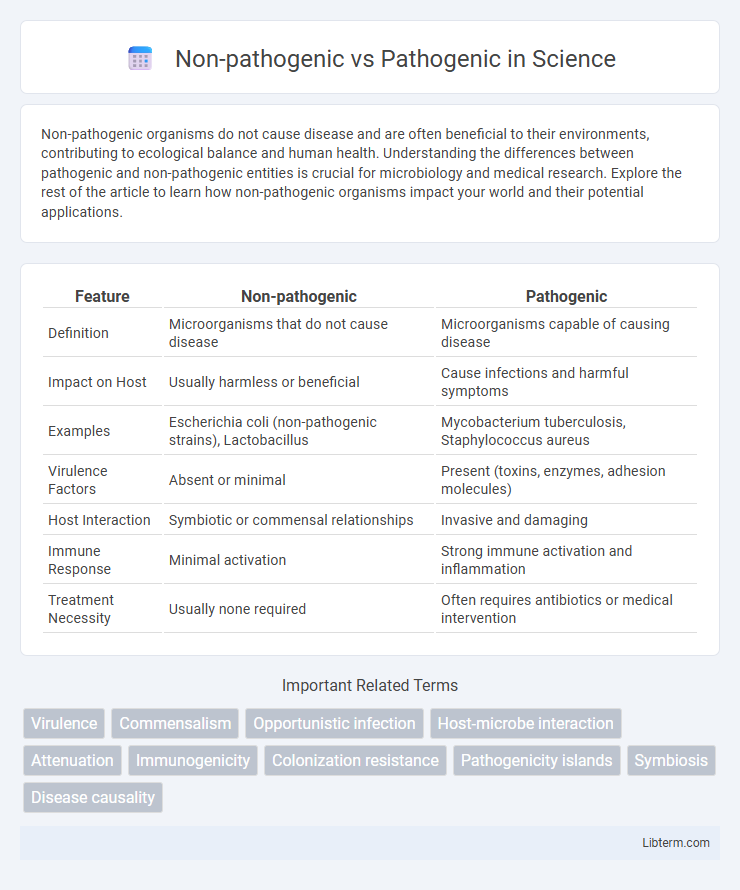Non-pathogenic organisms do not cause disease and are often beneficial to their environments, contributing to ecological balance and human health. Understanding the differences between pathogenic and non-pathogenic entities is crucial for microbiology and medical research. Explore the rest of the article to learn how non-pathogenic organisms impact your world and their potential applications.
Table of Comparison
| Feature | Non-pathogenic | Pathogenic |
|---|---|---|
| Definition | Microorganisms that do not cause disease | Microorganisms capable of causing disease |
| Impact on Host | Usually harmless or beneficial | Cause infections and harmful symptoms |
| Examples | Escherichia coli (non-pathogenic strains), Lactobacillus | Mycobacterium tuberculosis, Staphylococcus aureus |
| Virulence Factors | Absent or minimal | Present (toxins, enzymes, adhesion molecules) |
| Host Interaction | Symbiotic or commensal relationships | Invasive and damaging |
| Immune Response | Minimal activation | Strong immune activation and inflammation |
| Treatment Necessity | Usually none required | Often requires antibiotics or medical intervention |
Introduction to Pathogenic and Non-Pathogenic Organisms
Pathogenic organisms cause diseases by invading host tissues and evading immune responses, leading to symptoms and health complications. Non-pathogenic organisms coexist with their hosts without causing harm, often contributing to processes such as digestion and immune system support. Understanding the distinction between pathogenic and non-pathogenic microbes is crucial for developing effective disease prevention and treatment strategies.
Defining Pathogenicity: What Makes an Organism Harmful?
Pathogenicity is defined by an organism's ability to cause disease by invading host tissues, evading immune responses, and producing toxins or enzymes that damage cells. Unlike non-pathogenic organisms, which coexist harmlessly or beneficially within a host, pathogenic entities possess specific virulence factors such as adhesins, invasins, and exotoxins that enable harmful interactions. These biological mechanisms determine the organism's capacity to disrupt normal physiological functions and trigger pathological conditions.
Key Differences Between Pathogenic and Non-Pathogenic Microbes
Pathogenic microbes cause diseases in hosts by disrupting normal biological functions, whereas non-pathogenic microbes coexist without causing harm and often provide beneficial effects such as aiding digestion or supporting immune function. Key differences include the presence of virulence factors in pathogenic microbes that facilitate infection and damage, while non-pathogenic microbes lack these traits and contribute to homeostasis. Pathogens typically elicit immune responses leading to symptoms, contrasting with non-pathogens that are either neutral or symbiotic within the host environment.
Types of Pathogenic Microorganisms
Pathogenic microorganisms include bacteria, viruses, fungi, and parasites that cause diseases in humans, animals, or plants by invading host tissues and disrupting normal functions. Common bacterial pathogens such as *Mycobacterium tuberculosis* and *Staphylococcus aureus* are responsible for severe infections, while viruses like influenza and HIV target specific cells to replicate. Fungal pathogens like *Candida albicans* and parasitic protozoa such as *Plasmodium falciparum* also contribute significantly to global disease burden through various modes of transmission and host exploitation.
Common Examples of Non-Pathogenic Organisms
Non-pathogenic organisms, such as Lactobacillus species and Saccharomyces cerevisiae, play essential roles in fermentation, food production, and maintaining human microbiota health. Unlike pathogenic bacteria like Escherichia coli O157:H7 or Staphylococcus aureus, non-pathogenic strains typically do not cause disease and often contribute to environmental balance and host immunity. Common non-pathogenic microbes include Bacillus subtilis, frequently used in probiotics, and Rhizobium species, important for nitrogen fixation in soil.
Mechanisms of Pathogenesis: How Pathogens Cause Disease
Pathogenic organisms cause disease by invading host tissues, evading immune responses, and producing toxins that disrupt normal cellular functions, leading to tissue damage and inflammation. Non-pathogenic microbes lack these virulence factors and do not trigger harmful host responses, often existing as harmless commensals or mutualists. Understanding mechanisms such as adhesion, invasion, toxin production, and immune evasion highlights the distinction between pathogenic and non-pathogenic microbial interactions with the host.
Roles of Non-Pathogenic Microbes in Health and Environment
Non-pathogenic microbes play crucial roles in promoting human health by aiding digestion, synthesizing essential vitamins, and modulating the immune system. In the environment, these beneficial microorganisms contribute to nutrient cycling, soil fertility, and bioremediation by breaking down organic matter and pollutants. Unlike pathogenic microbes that cause diseases, non-pathogenic microbes maintain ecological balance and support overall ecosystem stability.
Host Factors Influencing Pathogenicity
Host factors such as genetic makeup, immune system strength, and microbiome composition critically influence the pathogenicity of microbes. Variations in host receptors and immune response mechanisms determine whether a microorganism exhibits non-pathogenic or pathogenic behavior. Nutritional status and underlying health conditions also modulate susceptibility, impacting the host's ability to control or promote microbial pathogenicity.
Detection and Identification Methods for Pathogenic Species
Detection and identification of pathogenic species rely heavily on molecular techniques such as polymerase chain reaction (PCR) and next-generation sequencing (NGS), which allow precise differentiation from non-pathogenic strains. Immunological assays including enzyme-linked immunosorbent assay (ELISA) and lateral flow tests target specific antigens unique to pathogenic organisms. Culture-based methods combined with biochemical tests also aid in identifying pathogenic species by assessing growth characteristics and metabolic profiles specific to disease-causing microbes.
Implications for Medical Research and Disease Prevention
Non-pathogenic microorganisms play a crucial role in medical research by serving as baseline models to understand host-microbe interactions without causing disease, enabling the identification of virulence factors in pathogenic counterparts. The study of pathogenic organisms, such as Mycobacterium tuberculosis and Staphylococcus aureus, provides insights into mechanisms of infection, immune evasion, and antibiotic resistance, which are vital for developing targeted therapies and vaccines. Differentiating between non-pathogenic and pathogenic strains enhances disease prevention strategies through improved diagnostics, effective antimicrobial development, and optimized public health interventions.
Non-pathogenic Infographic

 libterm.com
libterm.com